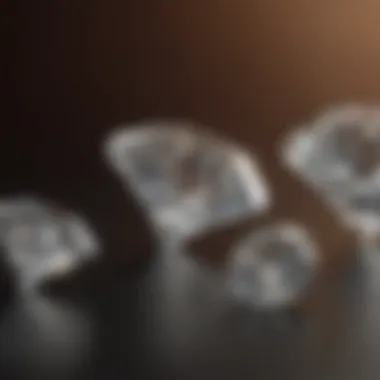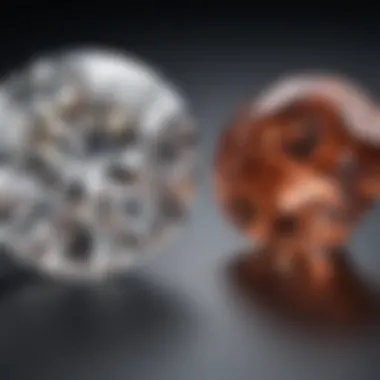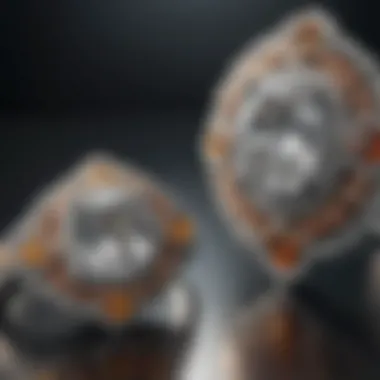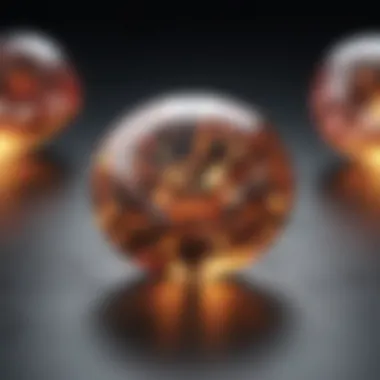Comparative Analysis of 2 Carat vs 3 Carat Diamonds


Intro
In the world of gemstones, diamonds hold a prestigious place. Among them, the distinction between carat weights, particularly 2 carats and 3 carats, often emerges as a focal point for buyers and collectors. This analysis delves into these two popular sizes, exploring their differences in size, cost, aesthetics, and even investment potential. Understanding these factors can guide consumers in making informed choices on their diamond purchases.
Gemstone Overview
Diamonds are well-known for their brilliance and durability. As a form of carbon, they crystallize under intense pressure deep within the Earth. The carat weight of a diamond is a significant aspect that influences its value. Larger stones tend to be rarer and more expensive.
Definition and Characteristics
Carat, a term that originates from the carob seeds formerly used to balance scales, defines the weight of a diamond. One carat equals 200 milligrams. Therefore, a 2-carat diamond weighs 400 milligrams, while a 3-carat diamond weighs 600 milligrams. These slight differences in carat weight can lead to noticeable variations in size when viewing the diamonds side by side.
Classification of Gemstones
Gemstones are classified by their mineral and crystal structures. Diamonds fall under the category of precious gemstones. Not only do their physical properties make them desirable, but their rarity in particular sizes, such as 2 and 3 carats, contributes to their allure.
Historical Significance
Diamonds have a rich history that dates back to ancient civilizations. They were often associated with strength and invincibility, making them popular in royal adornments.
Ancient Uses and Cultural Importance
In ancient India, diamonds were regarded as sacred and used as talismans for protection. They symbolized power and status among royalties in Europe and Asia alike. Their historical value continues to play a role in contemporary jewelry design, reinforcing their demand.
Myths and Legends Surrounding Gemstones
Many cultures have myths about diamonds, attributing various meanings to them. They are often considered to bring good fortune, clarity, and enlightenment. Such beliefs add an element of mystique to diamonds, influencing consumer choices even today.
"Diamonds are not just a girl's best friend; they are also a significant investment that reflects one's discernment and wealth."
Foreword to Diamond Carat Weight
Understanding diamond carat weight is crucial for anyone interested in purchasing or investing in diamonds. Carat weight directly influences the size and appearance of a diamond, impacting its overall value. When comparing gems, particularly those around the 2 ct and 3 ct range, recognizing these nuances is vital. This section will discuss how carat weight affects quality, pricing, and the final choice for various types of jewelry.
Understanding Carat Weight
Carat weight refers to the weight of a diamond, with one carat equaling 200 milligrams. This term is derived from the carob seeds historically used as counterweights on balance scales when trading gemstones. A diamond's carat weight does not equate to size; cut, shape, and proportions also play significant roles in its visible dimensions. Therefore, when assessing a diamond, it’s essential to look beyond mere weight.
For example, a well-cut 2 ct diamond might appear larger than a poorly cut 3 ct diamond due to its proportions and brilliance. Buyers should focus on the "weight-to-size" ratio and not just the number on the scale. It helps in making a more informed decision, especially when selecting a diamond for a specific setting.
The Importance of Carat in Diamonds


Carat weight plays a significant role in the grading and pricing of diamonds. Generally, as the carat weight increases, so does the price. This is due to the rarity of larger diamonds, making them more desirable in the market. However, it is worth noting that price increases are not linear – a 3 ct diamond may cost much more than a 2 ct diamond, reflecting the exponential rise in demand for larger stones.
In practice, the carat weight can help guide consumers in determining their budget and expectations. Buyers often find that a 2 ct diamond provides a considerable visual impact, balancing size and cost effectively, while a 3 ct diamond makes a striking statement.
"The weight of diamonds is among the factors that significantly affect their market value, making an understanding of carat weight essential for buyers."
Thinking about diamond carat weight involves looking at personal preference and financial considerations. Couples often choose their ideal weight based on factors that align with their taste and budget, ensuring they make a choice that resonates with both aesthetics and practicality. Understanding these elements strengthens the buyer’s position in the diamond market.
Characteristics of ct Diamonds
The examination of 2 carat diamonds is central to understanding their place in the jewelry market. These diamonds represent a significant balance between size and cost, making them appealing choices for both personal adornment and investment. Consumers often view the 2 ct diamond as a symbol of quality. This section discusses the physical characteristics, pricing dynamics, and suitable settings for 2 ct diamonds, providing essential insights for potential buyers.
Physical Size and Appearance
A 2 ct diamond typically measures approximately 8.1 mm in diameter when cut in a round shape. This size often delivers a noticeable presence on the hand, making it an ideal choice for engagement rings or statement pieces. The appearance of a 2 ct diamond can vary based on its cut, clarity, color, and the settings used. A well-cut diamond can maximize light reflection, enhancing its sparkle and brilliance.
Consumers should consider how a diamond's cut affects its perceived size. Certain cuts, such as oval or marquise, can create an illusion of greater size. Therefore, many buyers opt for these shapes to achieve a larger look without increasing carat weight. When evaluating a 2 ct diamond, the visual impact and overall aesthetic should align with the buyer's preferences and needs.
Market Price Range
The market price for a 2 ct diamond can fluctuate significantly due to several factors, including clarity, color, cut quality, and even market demand. On average, a 2 ct diamond can range from $10,000 to $20,000. Factors impacting price include:
- Clarity: Higher clarity grades can command a premium. Diamonds with fewer inclusions or blemishes often appeal more to buyers.
- Color Grade: Diamonds closer to colorless receive higher prices, while those with noticeable color might be more affordable.
- Cut Quality: Excellent or ideal cut classifications enhance the diamond's beauty and typically support a higher price.
Understanding these price dynamics is crucial for buyers. They should feel comfortable negotiating and ensuring they receive a fair valuation for their purchase. Additionally, checking multiple retailers can often yield variations in pricing based on the same characteristics.
Ideal for Which Settings
Two carat diamonds are versatile and adapt well to various jewelry settings. Their significant weight allows them to shine in both classic and modern designs. Some suitable settings for these diamonds include:
- Solitaire Settings: This classic design enhances simplicity, focusing on the diamond's beauty.
- Halo Settings: Surrounding a 2 ct diamond with smaller stones can amplify its size and sparkle, creating a more dramatic appearance.
- Three-Stone Settings: This arrangement symbolizes the past, present, and future, often appealing to those with sentimental value in their purchases.
When selecting a setting, buyers should consider their lifestyle and personal preferences. Some settings provide more durability, while others may require careful maintenance. Selecting the right setting can elevate the overall charm of the 2 ct diamond, serving as a true reflection of the wearer's style.
Characteristics of ct Diamonds
Understanding the characteristics of 3 carat diamonds is essential for prospective buyers and collectors. These diamonds are not just larger stones; they represent a unique blend of visual appeal, market value, and suitability for various jewelry types. The increased size often translates into a more significant economic investment, thus necessitating careful consideration. This section delves into the physical size and impact, market price range, and the types of jewelry that best showcase these impressive gems.
Physical Size and Visual Impact
A 3 carat diamond has a notable physical size compared to smaller diamonds. Generally speaking, a 3 carat diamond can have a diameter of approximately 9.3mm to 9.5mm, depending on its cut. This size creates a stunning visual impact, making it an eye-catching piece in any jewelry setting. The larger surface area enhances the diamond's ability to refract light, leading to a more brilliant sparkle.


However, one must consider personal preferences as well. A diamond of this size may command attention not just for its weight but also for its presence. Often, a 3 carat diamond is seen as a status symbol, and it can evoke different perceptions. Some may find such a large stone too ostentatious, while others could consider it an ideal centerpiece.
Market Price Range
The market price for a 3 carat diamond varies considerably based on several factors, including cut, clarity, color, and origin. Estimates suggest that prices can range from $20,000 to $50,000 and beyond. The highest quality stones often demand prices that can surpass these estimates dramatically. As with any diamond, clarity and color grades are especially influential on the price.
When considering a purchase, it is vital to compare stones based on these attributes. Also, seeking guidance from reputable jewelers can help ensure informed decisions. The investment in a 3 carat diamond suggests a commitment, not just to beauty, but also to long-term value.
Best Type of Jewelry for ct Diamonds
A 3 carat diamond finds its best expression in several types of jewelry. Engagement rings are arguably the most popular, making a bold statement about commitment. In addition to rings, these larger stones can also be fitting in earrings, where the prominent size can enhance one’s facial features.
Generally, the following types of jewelry complement a 3 carat diamond effectively:
- Engagement Rings: The center stone captivates with its brilliance and size.
- Earrings: As dangle or stud earrings, 3 carat diamonds create visual balance and elegance.
- Necklaces: Whether as a pendant or part of a more complex design, the size draws the eye.
A 3 carat diamond does not just signify weight; it signifies a commitment to quality and craftsmanship in a piece of jewelry.
The choice of mount plays a crucial role as well. Settings such as halo, four-prong, or pave-style can amplify the diamond’s visual impact. Overall, understanding the characteristics of a 3 carat diamond helps buyers make thoughtful decisions, ensuring their investment meets both aesthetic and financial expectations.
Key Differences Between ct and ct Diamonds
Understanding the differences between 2 ct and 3 ct diamonds is crucial for consumers and collectors. As carat weight heavily influences the overall aesthetics, value, and investment potential of diamonds, these differences guide purchasing decisions. Knowing how each carat weight compares can lead to a more informed choice for those seeking to buy a diamond, whether for engagement rings, earrings, or necklaces. Additionally, recognizing consumer preferences can shape market trends, impacting the overall demand for different carat weights.
Carat Weight and Size Comparison
When comparing the carat weight between 2 ct and 3 ct diamonds, the size difference becomes evident. Generally, a 2 ct diamond measures around 8.1 mm in diameter, whereas a 3 ct diamond is approximately 9.3 mm. This slight increase in size can significantly affect visual impact. A larger diamond can appear more prominent and satisfy buyers who seek a statement piece. However, individual preferences on size play a big role. Some may prefer a more subtle look with a 2 ct diamond, while others may view the 3 ct stone as more impressive.
Price Variability and Factors Influencing Cost
The cost between these two carat weights varies significantly. While a 2 ct diamond can range from $8,000 to $15,000 depending on the quality of the cut, clarity, and color, a 3 ct diamond is usually priced between $15,000 to $30,000. The increase in price is not linear; owing to the rarity of larger diamonds, the price per carat can increase exponentially. Factors influencing this cost include:
- Cut Quality: A well-cut diamond reflects more light, improving visual appeal and increasing its value.
- Clarity: Higher clarity stones are rarer and demand higher prices.
- Color Grade: Fancy colored diamonds can fetch higher prices, and color weight directly affects value.
- Settings and Jewelry Type: Priced differently based on the complexity of the setting and style.
Consumer Preferences in the Market
Market preferences can vary widely. In general, younger couples might favor 2 ct diamonds for their balance of size and affordability. Meanwhile, traditional buyers or collectors may lean toward 3 ct diamonds, viewing them as a long-term investment due to their striking presence and perceived exclusivity.
According to recent trends, more consumers are now prioritizing quality over size. This shift in preference shows that factors like cut and clarity might hold more value compared to just the carat weight alone. Greater awareness and education about diamond characteristics are also guiding buyers towards making smarter choices.
"Buying a diamond is not just about the stone, but understanding the nuances that go into them."


Thus, understanding these key differences not only aids in selecting the right diamond but also plays a big part in potential resale value and market demand.
Investment Considerations
Understanding investment considerations when buying diamonds is essential for anyone looking to purchase high-value gemstones. This section addresses several key elements that affect the long-term value and resale potential of diamonds. It is crucial for both collectors and casual buyers to recognize how various factors such as carat weight, market trends, and durability impact their investment.
Resale Value Comparisons
The resale value of diamonds can vary significantly based on several factors. When comparing 2-carat and 3-carat diamonds, it is important to note that larger stones often command higher resale prices. However, the exact resale value depends not only on carat weight but also on quality factors such as cut, clarity, and color.
- Quality Over Size: A high-quality 2-carat diamond might have a better resale value than a poorly cut 3-carat diamond. Thus, quality must take precedence over carat weight.
- Market Demand: The demand for larger diamonds generally increases their value, but trends can change. For instance, if a specific style or size becomes fashionable, it can elevate prices accordingly.
- Historical Data: Researching previous sales can provide insight into what similar diamonds have sold for in the past, helping to set realistic expectations.
“Investing in diamonds means looking beyond just the carat weight; the overall quality is what holds true value.”
Market Trends and Forecasts
Analyzing market trends is vital for making informed purchasing decisions. The diamond market is influenced by various factors, including economic conditions, consumer preferences, and supply chain challenges.
- Economic Conditions: Economic stability can lead to increased sales in luxury goods, including diamonds. Understanding the economic climate can help predict if the investment will appreciate.
- Emerging Trends: Social media and influencers play a significant role in shaping consumer desires and preferences. Monitoring these trends can help buyers anticipate which types of diamonds will be in demand in the coming years.
- Future Projections: Industry experts often publish forecasts about diamond market trends. These projections can provide useful guidance for potential investors regarding which carat weight could appreciate in value.
Long-term Value and Durability
The long-term durability of diamonds makes them a unique investment. Unlike many other luxury items, diamonds tend to hold their value well over time. Understanding their durability helps collectors and investors recognize the potential for long-term returns.
- Natural Resilience: Diamonds are renowned for their strength. This characteristic ensures that even if market conditions fluctuate, the physical gemstone remains intact and valuable.
- Timeless Appeal: The allure of diamonds as a symbol of love and commitment contributes to their enduring demand, thereby safeguarding their investment value.
- Care and Maintenance: Properly maintaining diamonds also ensures their longevity and value retention. Regular cleaning and appropriate storage can prevent damage and wear.
By considering these factors, investors can make informed decisions when purchasing diamonds, specifically between 2-carat and 3-carat options. The choices they make today can significantly impact their financial security in the future.
Finale and Recommendations
The final section of this article discusses the critical insights gathered regarding 2 ct and 3 ct diamonds. It is essential to comprehend the nuances involved in choosing a diamond that meets one’s specific needs. This section will highlight how the findings can assist individuals in making informed, prudent decisions.
Choosing the Right Carat for Your Needs
Choosing the appropriate carat weight impacts not only the visual appeal of the diamond but also its viability as an investment. Here are some essential aspects to consider:
- Budget Constraints: Carat weight often directly correlates to price. Assess your budget early in the decision-making process.
- Personal Preferences: Consider how the size and appearance resonate with your style. Individual taste plays a crucial role in this choice.
- Purpose: The occasion matters. An engagement ring may have different requirements than a piece meant for daily wear.
- Setting Compatibility: The size of the diamond should match the jewelry setting. A skilled jeweler can offer advice on the ideal combination.
Final Thoughts on ct vs ct Diamonds
Overall, the choice between a 2 ct and a 3 ct diamond encapsulates more than mere numbers. Each carat weight carries distinct characteristics that can align differently with consumer needs. Here are a few concluding points:
"Choosing a diamond is not just about size; it entails an understanding of value, aesthetics, and individual taste."
- Market Trends: Keep an eye on market trends as they can influence pricing. Understanding these patterns may enhance your purchasing strategy.
- Investment Potential: Larger diamonds may hold more appeal in the investment market, but 2 ct diamonds still can provide significant returns over time.
- Aesthetic Comparison: A 3 ct diamond has a noticeable visual impact, while a 2 ct diamond may offer a more understated elegance that some consumers prefer.
In essence, both carats have unique merits. Spend time understanding your needs and preferences, and you will make a choice that you are truly satisfied with.







